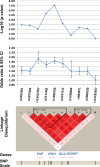IFIH1 polymorphisms are significantly associated with type 1 diabetes and IFIH1 gene expression in peripheral blood mononuclear cells
- PMID: 18927125
- PMCID: PMC2638779
- DOI: 10.1093/hmg/ddn342
IFIH1 polymorphisms are significantly associated with type 1 diabetes and IFIH1 gene expression in peripheral blood mononuclear cells
Abstract
Genome-wide association (GWA) studies revealed a number of single nucleotide polymorphisms (SNPs) significantly associated with type 1 diabetes (T1D). In an attempt to confirm some of these candidate associations, we genotyped 2046 Caucasian patients and 2417 normal controls from the United States for SNPs in five genomic regions. While no evidence was obtained for four genomic regions (rs2929366/NM_144715 on chromosome 3, rs9127/Q7Z4C4 on chromosome 5, rs1445898/CAPSL on chromosome 5 and rs2302188/NM_033543 on chromosome 19), we provide strong evidence for association between T1D and multiple SNPs in the IFIH1 linkage disequilibrium (LD) block on chromosome 2q. Among the 10 SNPs genotyped for the 2q region, four SNPs located within the IFIH1 gene or at the 5' region of IFIH1 showed significant association with T1D in the Georgia population [odds ratio (OR) = 1.7-1.9] with the best P-value found at SNP rs1990760 (P = 8 x 10(-8) and OR = 1.9). Several SNPs outside of the IFIH1 gene also showed significant but weaker associations. Furthermore, IFIH1 gene expression levels in peripheral blood mononuclear cells are significantly correlated with IFIH1 genotypes, and higher IFIH1 levels are found in individuals with the susceptible genotypes (P = 0.005). Thus, both genetic association and gene expression data suggest that IFIH1 is the most plausible candidate gene implicated in T1D in this LD block.
Figures


Similar articles
-
Cumulative effect of IFIH1 variants and increased gene expression associated with type 1 diabetes.Diabetes Res Clin Pract. 2015 Feb;107(2):259-66. doi: 10.1016/j.diabres.2014.11.008. Epub 2014 Dec 4. Diabetes Res Clin Pract. 2015. PMID: 25515714
-
The A allele of the rs1990760 polymorphism in the IFIH1 gene is associated with protection for arterial hypertension in type 1 diabetic patients and with expression of this gene in human mononuclear cells.PLoS One. 2013 Dec 27;8(12):e83451. doi: 10.1371/journal.pone.0083451. eCollection 2013. PLoS One. 2013. PMID: 24386202 Free PMC article.
-
Effects of type 1 diabetes-associated IFIH1 polymorphisms on MDA5 function and expression.Curr Diab Rep. 2015 Nov;15(11):96. doi: 10.1007/s11892-015-0656-8. Curr Diab Rep. 2015. PMID: 26385483 Review.
-
Association of the rs1990760, rs3747517, and rs10930046 polymorphisms in the IFIH1 gene with susceptibility to autoimmune diseases: a meta-analysis.Front Immunol. 2023 Jun 23;14:1051247. doi: 10.3389/fimmu.2023.1051247. eCollection 2023. Front Immunol. 2023. PMID: 37426657 Free PMC article.
-
Association of IFIH1 rs1990760 polymorphism with susceptibility to autoimmune diseases: a meta-analysis.Autoimmunity. 2013 Nov;46(7):455-62. doi: 10.3109/08916934.2013.796937. Epub 2013 Jun 4. Autoimmunity. 2013. PMID: 23734776 Review.
Cited by
-
99th Dahlem conference on infection, inflammation and chronic inflammatory disorders: viruses, autoimmunity and immunoregulation.Clin Exp Immunol. 2010 Apr;160(1):113-9. doi: 10.1111/j.1365-2249.2010.04128.x. Clin Exp Immunol. 2010. PMID: 20415860 Free PMC article.
-
Enteroviruses, type 1 diabetes and hygiene: a complex relationship.Rev Med Virol. 2010 Mar;20(2):106-16. doi: 10.1002/rmv.639. Rev Med Virol. 2010. PMID: 20049905 Free PMC article. Review.
-
The rs1990760 polymorphism within the IFIH1 locus is not associated with Graves' disease, Hashimoto's thyroiditis and Addison's disease.BMC Med Genet. 2009 Dec 4;10:126. doi: 10.1186/1471-2350-10-126. BMC Med Genet. 2009. PMID: 19961590 Free PMC article.
-
Linkage analysis using whole exome sequencing data implicates SLC17A1, SLC17A3, TATDN2 and TMEM131L in type 1 diabetes in Kuwaiti families.Sci Rep. 2023 Sep 11;13(1):14978. doi: 10.1038/s41598-023-42255-2. Sci Rep. 2023. PMID: 37696853 Free PMC article.
-
Influence of type 1 diabetes genes on disease progression: similarities and differences between countries.Curr Diab Rep. 2012 Oct;12(5):447-55. doi: 10.1007/s11892-012-0310-7. Curr Diab Rep. 2012. PMID: 22895852 Review.
References
-
- Smyth D.J., Cooper J.D., Bailey R., Field S., Burren O., Smink L.J., Guja C., Ionescu-Tirgoviste C., Widmer B., Dunger D.B., et al. A genome-wide association study of nonsynonymous SNPs identifies a type 1 diabetes locus in the interferon-induced helicase (IFIH1) region. Nat. Genet. 2006;38:617–619. - PubMed
-
- Sladek R., Rocheleau G., Rung J., Dina C., Shen L., Serre D., Boutin P., Vincent D., Belisle A., Hadjadj S., et al. A genome-wide association study identifies novel risk loci for type 2 diabetes. Nature. 2007;445:881–885. - PubMed
-
- Saxena R., Voight B.F., Lyssenko V., Burtt N.P., de Bakker P.I.W., Chen H., Roix J.J., Kathiresan S., Hirschhorn J.N., et al. Diabetes Genetics Initiative of Broad Institute of Harvard and MIT, Lund University, and Novartis Institutes of BioMedical Research. Genome-wide association analysis identifies loci for type 2 diabetes and triglyceride levels. Science. 2007;316:1331–1336. - PubMed
Publication types
MeSH terms
Substances
Grants and funding
LinkOut - more resources
Full Text Sources
Other Literature Sources
Medical
Research Materials

